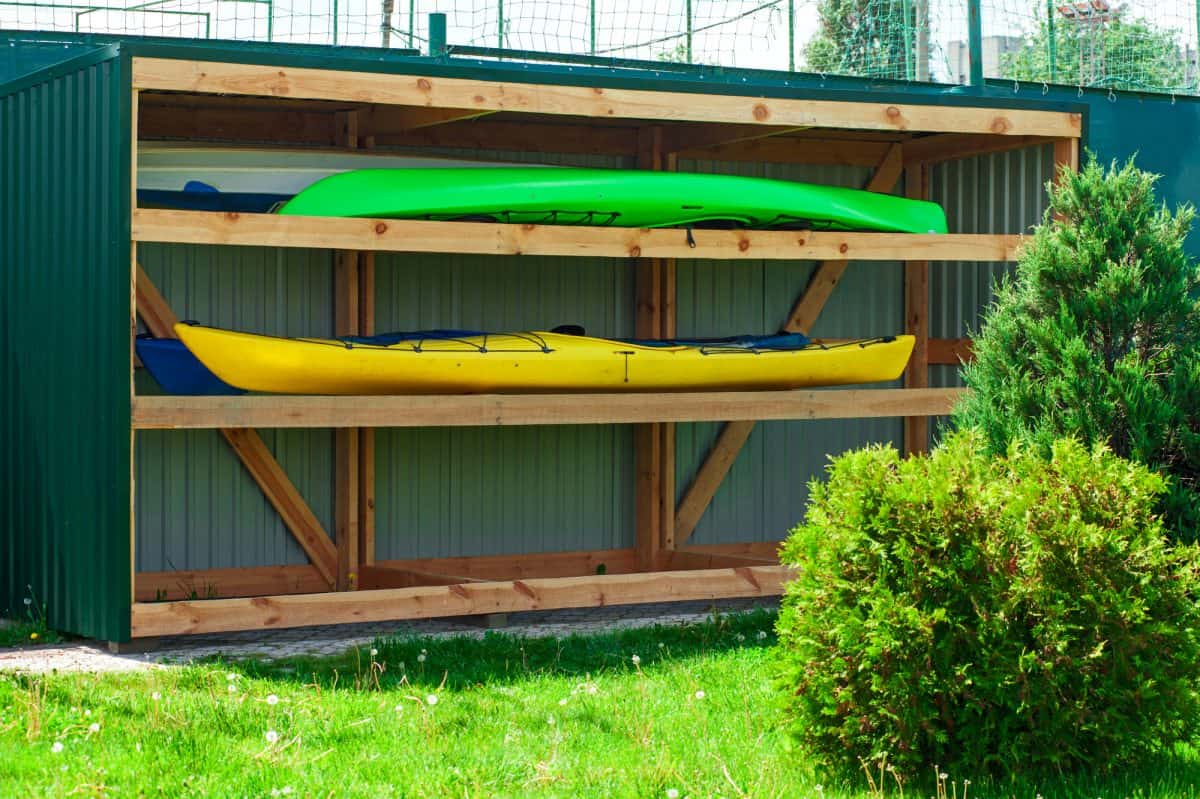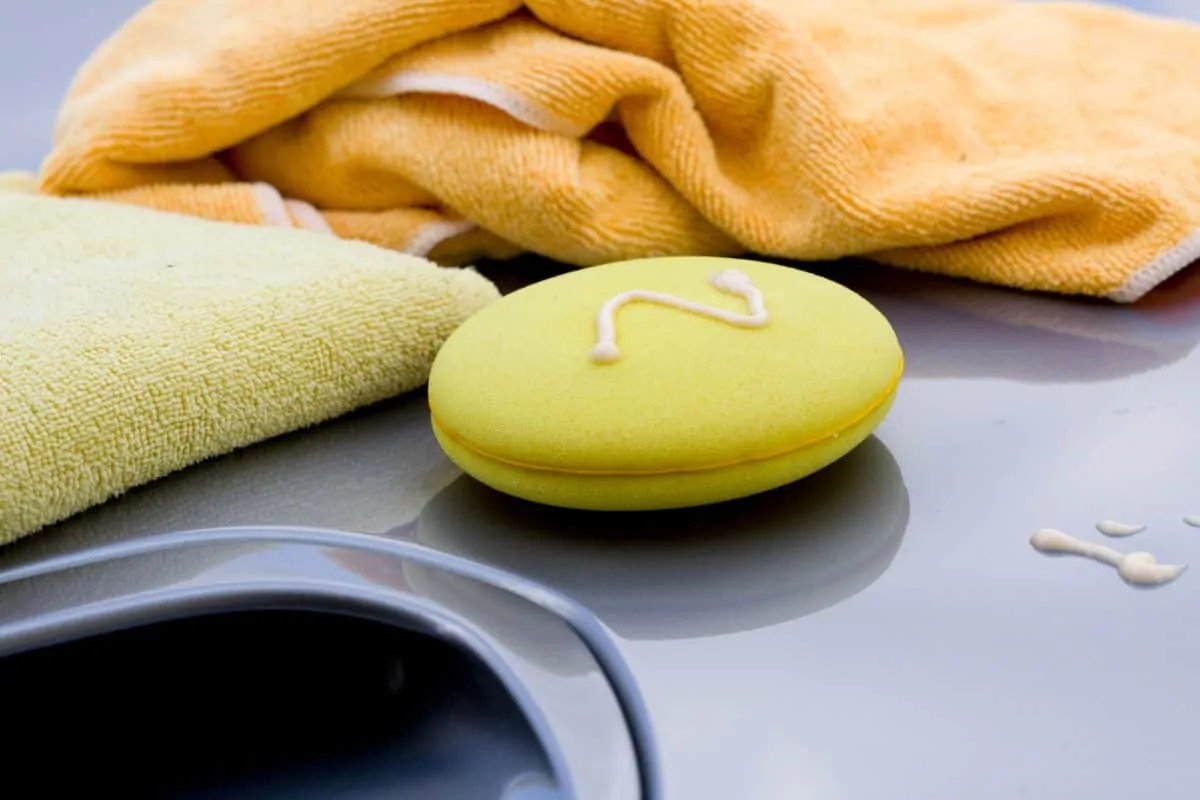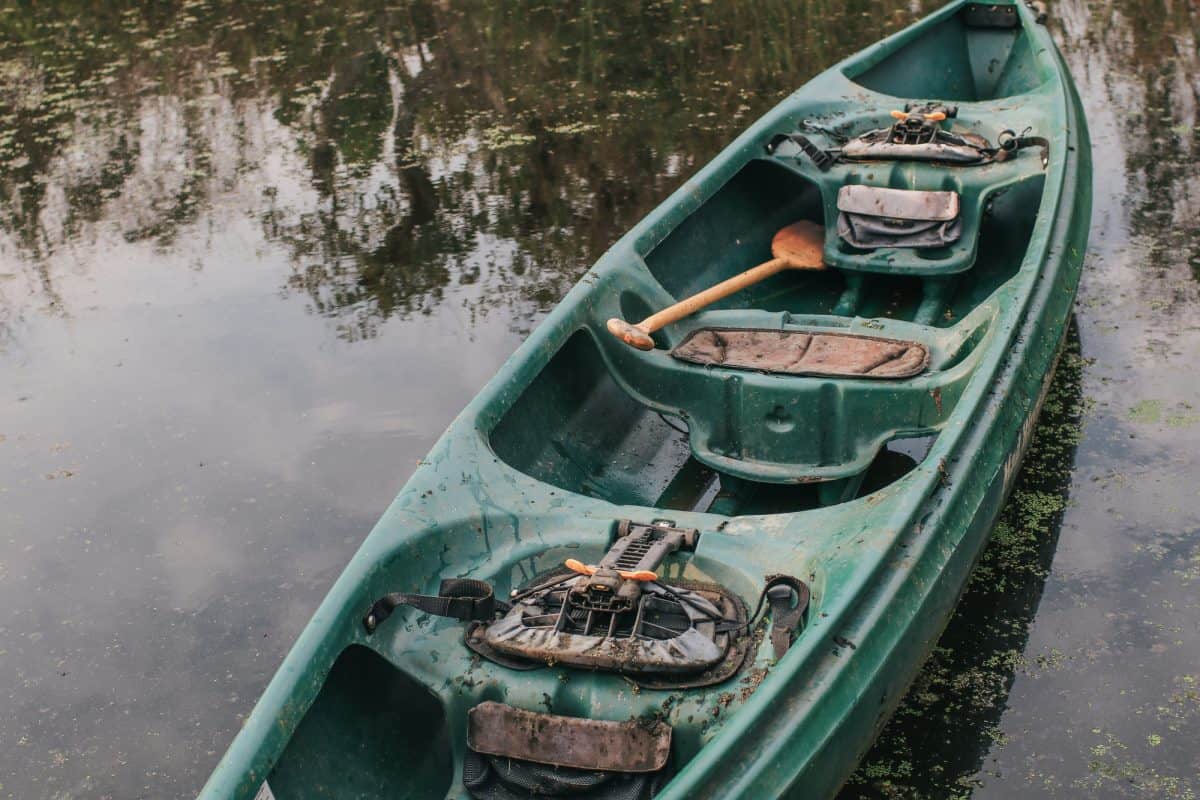The worst thing to do to a kayak is to drag it straight from the water to your garage and leave it there.
Hull damage, warping, rodent infestations, fading, mold, theft – the list of reasons why this is such a terrible idea is a pretty long one.
How the heck are you supposed to store a kayak, then?
I’ll go over the rules of proper kayak storage, underline some common mistakes, and help you figure out where and how to store a kayak. In short, I have your back!
Kayak Storage – Key Takeaways
- Why proper storage is important – To prolong the life of your kayak, it is essential to store it correctly. This will help protect it from harsh weather and extreme temperatures, prevent damage to the hull, keep it secure, and minimize the risk of accidents or injuries.
- Kayak storage options – When it comes to kayak storage solutions, you have three space-saving and efficient options; racks, hoists, and stands.
- What is the is best kayak storage method? – The right kayak storage solution for you depends on the size and weight of your kayak, whether or not you need to store multiple kayaks, the space you have available, and the budget you have to spend.
- Is outdoor or indoor storage best? – If possible, and you have the floor space, it’s best to keep your kayak stored indoors for maximum protection from the elements and theft. However, if indoor storage isn’t feasible, and as long as you take appropriate precautions, outdoor storage is still a viable option.
- Storing a kayak outdoors – To prevent your kayak from being damaged by moisture, UV rays, and extreme temperatures when storing it outdoors, it is important to choose a location that minimizes its exposure to these elements. Some options for outdoor kayak storage include: under a deck, on a covered porch, beneath the eaves of a roof, under a waterproof and UV-resistant tarp, mounted on a sidewall or fence, or a free-standing kayak rack.
- Indoor kayak storage –It is generally best to store your kayak indoors in order to protect it from the sun, extreme temperatures, pests, and other environmental factors. Some suitable indoor storage locations for a kayak include a spare room, garage, basement, or shed.
- How to prepare a kayak for long-term storage – If you will be storing your kayak for an extended period of time, it is important to take some steps to protect it. First, remove the seat and any accessories – and store them separately. Next, clean the kayak with mild soap and water, allow it to dry, and then apply sun-protective spray or marine wax. Finally, close all hatches and compartments, and store the kayak in a protective cover or use a tarp to shield it from the elements.
- Kayak storage tips – To ensure the longevity of your kayak, it is important to avoid the following mistakes when storing it: laying the kayak on a hard flat surface, hanging it by its handles or grab loops, leaving the cockpit uncovered, leaving it in direct sunlight, leaving it unlocked, and strapping it down too tightly. These poor practices can damage the kayak and significantly shorten its lifespan.
Importance Of Good Kayak Storage Practices: 4 Reasons To Store A Kayak

You’ve likely spent a fair amount of money on that boat of yours. So, it makes sense that you want to keep it in top shape for years of adventures to come.
And the better you store your kayak, the longer it will last.
Whether it’s a short-term storage solution until the next trip or you’re putting it away for the season, there are numerous reasons why proper kayak storage and maintenance matter. You’ll find the four main ones listed below.
Reason #1: Protection From The Elements

Whether your kayak is made of plastic, wood, Carbon fiber, or other composite materials, the elements can – and will – cause damage to the hull.
Rain, UV rays from direct sunlight, snow, frost; exposure to the elements will gradually but surely wreak havoc on any kayak that isn’t stored correctly.
Even if you’re keeping your kayak indoors – let alone outside – you must do so correctly and protect it from extreme temperatures and weather changes.
Otherwise, you’re looking at hull damage, warping, fading – and a ruined kayak.
Reason #2: Preventing Damage & Deformity

Exposure to the weather can do a number on the hull – but the way you store your kayak can, too.
Here’s the thing:
A kayak that’s stored incorrectly – with the hull’s weight not being distributed evenly – will pretty much crumble under pressure. Dents, distortion, and deformation might not be evident immediately, but over time, on-the-water performance issues will rear their ugly heads.
Avoiding uneven weight distribution, especially during prolonged storage, and storing the kayak on its side, rather than flat on its hull, is one way to prevent such damage from occurring.
Reason #3: Security & Theft Protection

Quality kayaks can be quite an investment – and kayak theft is a thing. It’s always a good idea to take the necessary precautions to prevent it from getting stolen.
Storing your kayak in the house, garage, or any other locked area would be ideal.
If that’s not an option, though, the least you can do is making the kayak “difficult to steal.”
Tie it to a permanent structure with a security cable or chain and padlock and keep it out of sight – away from anyone who might want to snatch it.
Reason #4: Personal Safety

Although this bit often gets overlooked, knowing how to store a kayak can prevent accidents and ensure everyone’s safety.
Kayaks can weigh up to 80 pounds on average; can you imagine how dangerous it would be if it fell due to improper storage and injured someone?
Leaning the kayak against the wall or using less-than-secure suspension methods are a no-go safety-wise. Even if you’re lucky enough to avoid injury when it falls, the hull will likely get damaged at impact.
Indoor Vs. Outdoor Storage Options: Where To Store A Kayak?
In terms of where and how to store kayaks, you have two options – indoor and outdoor storage.
Inflatable kayaks or folding kayaks are easy; you fold them up and toss them away in a cool, dry space – but we all know how big and bulky hard-shell kayaks can get, though. Figuring out where to store one can be quite a challenge.
Here’s how to go about it!
Indoor Kayak Storage 101: How To Store Kayak In Garage?

Storing a kayak indoors – if you have the room for it – is the preferred option:
It protects your boat from direct sunlight, extreme temperatures, pests, the elements – anything that’s out to destroy it. A spare room, garage, basement, or shed; any solid construction with a roof over it would do.
However, you still have to take the necessary precautions to prevent hull damage and deformation.
There are many ways of storing kayaks, but if you’re wondering about the best way to store kayak in garage, here are the golden rules of how to store your kayak indoors;
- Avoid having the kayak laid on the ground on its hull. You’d be surprised how quickly ABS and rotomolded plastic hulls can warp when left flat on hard surfaces. Kayaks aren’t supposed to sit directly on the hull for extended periods – no ifs, ands, or buts.
- Can you store a kayak on its end, then? Yes, keeping the kayak vertically – upright on its stern, with the hull strapped against the wall – can help minimize the pressure. Be sure to add some padding under the stern to protect the kayak’s finish.
- Keep the kayak off the ground if possible. There are various kayak-mounting solutions worth considering, including storage rack systems, web slings, and overhead pulley systems on which to hang your kayak – all of which will keep your yak off the ground. Take your pick!
- Distribute the hull’s weight evenly and avoid pressure points. Whether you opt for a storage rack or a ceiling suspension hoist system, position it hull-side up and distribute the support evenly along the kayak’s length. Wide nylon straps and padded cradles that match the hull’s curve are an excellent option – They keep your kayak on its side and protect your kayak from any pressure damage. But never hang you a kayak by its grab loops, the stress placed on the kayak could cause it to deform and result in you owning a banana shaped boat!
- Get it away from any heat sources. Storing the kayak near heaters or furnaces could cause the hull to warp and deform due to excessive heat. Also, pick a room that keep your kayak at a relatively consistent temperature and humidity levels.
Outdoor Kayak Storage 101: How To Store A Kayak Outside?

Storing your kayak outdoors, long term, certainly isn’t ideal, but if you’re working with limited indoor space – and there’s no way to squeeze a kayak in – it’ll have to do.
Also, if you think about it, storing your kayak outside is relatively similar to indoor storage. The rules regarding positioning, safety, and preventing hull damage in general still hold.
So, what’s the big difference, then?
It mostly comes down to putting in a bit more effort to protect your kayak from the elements and potential thieves.
On that note, a good location for outdoor kayak storage is one that limits exposure to moisture, UV rays, and extreme temperatures. Your options include:
- Under a deck
- On a covered porch
- Beneath the eaves of a roof
- Under a tent-like construction made from strung-up, waterproof, UV-resistant tarp
- Mounted on a sidewall or fence
- On a free-standing kayak rack
One rule to remember regarding how to store a kayak outside is to keep it covered and locked at all times.
How Do You Store A Kayak During Winter?

Sure, knowing how to store a kayak properly is essential during any season. When winter rolls around, though, and it’s time to put away your kayak for the season, you have to choose an adequate storage solution with care.
Cold temperatures and moisture working hand in hand during the winter months can – and will – wreak havoc on your kayak.
Finding appropriate shelter should be your primary concern. The best way to go about it is to store it indoors, protected from extreme weather. Outdoor storage could work during winter – as long as you keep the boat off the ground and wrapped in a kayak cover.
Generally speaking, though, I’d recommend the same practices for storing a kayak, regardless of the season:
Prepare it for storage (I’ll explain how in a second), pick a spot that protects it from the elements, position the hull properly, use a cover – and keep it locked.
Preparing Your Kayak For Long-Term Storage: Care & Maintenance Tips

Now that you’ve picked a suitable spot, it’s time to prepare your kayak for long-term storage. Otherwise, you might get back to it a few months down the line, ready to take it out on the water and find that it’s ruined beyond repair.
You’ll find the three fundamental rules of pre-storage kayak care listed below.
Remove The Seat & Other Gear

Start by emptying the boat. All the extra gear – including the paddle, spray skirt, life jacket, bilge pump, seating, storage bags, and the like – should be stored separately.
It might not seem necessary, but your kayaking accessories deserve the same pre-storage treatment as the kayak itself:
Give everything a thorough rinse, let it dry, and find a different storage spot for it, preferably indoors. Removing anything that could become an open invitation for mold or bug and rodent infestations – think fabric and foam components – is vital.
Plus, this gives you a chance to go over your gear and accessories and see if anything needs replacing.
Clean The Kayak & Let It Dry
Sand, mud, salt, and all sorts of dirt and debris can accumulate on the kayak’s hull; it’s a normal part of putting your kayak through its paces. Moving it straight to storage without a thorough wash is generally a bad idea, though.
It doesn’t have to be anything fancy – no one expects your kayak to look all shiny and new afterward – but it’s a crucial step in preventing hull deterioration.
If we’re talking short-term storage, a quick spray down with a garden hose will suffice. If you’re done paddling for the season and storing the kayak long-term, you’ll have to be more thorough than that, a good deep clean is required:
- Use mild, all-purpose soap and a sponge to wipe down both the hull and the cockpit. Don’t skip the nooks and crannies; get rid of any remaining dirt trapped in there.
- Rinse it thoroughly with water; you don’t want to leave soap residue anywhere on the hull’s surface.
- Let the kayak dry before storing it to prevent mold and mildew from growing. Drain the hatches and other compartments if needed, and use a soft towel to speed up the drying process.
- If you’d like to apply a layer of sun-protective spray (such as 303 UV protectant) or kayak wax, now’s a good time to do it.
Use A Storage Cover
The cover acts as an added layer of protection against the elements, moisture, dust, and critters that might invade your kayak’s hull. And yes, it’s mandatory regardless of where you’re storing the kayak – inside or outside.
You already cleaned your kayak inside and out. Why let all that effort go to waste by skipping a step as simple as using a storage cover?
Close up the hatches and watertight compartments, and wrap the entire thing with a protective kayak cover. For sit-inside kayaks, a cockpit cover – the same one you’d use when hauling a kayak – will do.
Draping a waterproof tarp over the kayak – or making a tent-like structure out of it – is also an option, as long as you leave some space between the two to avoid trapping moisture.
6 Kayak Storage Mistakes To Avoid: How NOT To Store A Kayak

Before I wrap things up, I’d like to go over some bad kayak storage practices that might cost you your kayak:
- DON’T Lay The Kayak On Hard Flat Surfaces – Under no circumstance should you leave the kayak sitting on a hard, flat surface as a long-term storage solution. Uneven weight distribution and the resulting abnormal pressure on the kayak-to-ground contact points can seriously distort the hull’s shape. Plastic kayaks are particularly prone to caving under their weight and developing flat spots and dents. It’s not uncommon to see first signs of hull deformation in a matter of days – and other factors only speed up the process.
- DON’T Hang The Kayak From Its Handles (or Grab Loops) – I get that it seems like a convenient solution for hanging your kayak but repeat after me: Handles are there to make carrying – not storing – the kayak easier. Best case scenario, the extended pressure will weaken the handles over time, causing them to break. Worst case scenario, you’ll be left with a banana-shaped kayak due to the bottom of the hull sagging under its weight.
- DON’T Leave The Cockpit Uncovered – Spiders, snakes, lizards, ants, and other bugs – even a family of raccoons – could view your uncovered kayak as free real estate. Don’t get me started on rodents and their reputation of chewing through anything – and everything – they come across. Sure, you can get rid of the unwanted guests, but the damage they did is often permanent. No matter how you cut it, leaving the cockpit uncovered is considered a bad practice. Invest in a good kayak cockpit cover – you will be glad you did
- DON’T Leave The Kayak In Direct Sunlight – As far as your kayak’s concerned, the sun is the enemy. Leaving your kayak exposed to direct sunlight is, quite possibly, the worst thing you could do. UV rays have a devastating effect on plastic, fading, and breaking it down over time. The kayak’s hull isn’t the only one to degrade and become brittle in direct sunlight, either. Any rubber, plastic, or foam accessories you have attached to it will likely get damaged, too. Top tip – If you use a rack to store your kayak outdoors then the rack is also subject to heat. The heat absorbed by the rack will transfer to the kayak – so make sure you protect both your kayak and rack from sunlight.
- DON’T Leave The Kayak Unlocked – Leaving a kayak unattended and unlocked when it’s not in use is pretty much an open invitation to have it stolen. Kayak theft has – surprisingly or not – been on the rise, with crooks looking to make a quick buck by reselling stolen boats. Even if it weren’t, I’d still advise you against leaving your kayak unlocked and making it an easy target for thieves. It’s a matter of protecting your investment, more than anything else.
- DON’T Strap It Down Too Tight – When you’re transporting the kayak, keeping the tie-down straps nice and tight is necessary. You don’t want it to move around, let alone fly off the roof or trailer, as you’re driving down the road. However, it’s not something you want to do when storing the kayak. Strapping it down too tight – and leaving it that way – is a surefire way to damage the hull due to excess pressure.
Final Thoughts On How To Store Kayaks
Whether you opt for outdoor or indoor storage, coming up with a proper long-term strategy for storing your kayak will likely take some time.
So, if anything, I hope this guide on how to store a kayak speeds up the process – and helps you avoid the common pitfalls of lousy storage practices.
You – and your kayak – can thank me later.
Remember:
Sunlight, moisture, extreme heat and cold, hull deformation – and unfortunately, thieves – are all things to be wary of when picking a suitable long-term storage location. As long as you plan and prepare for it, keeping your precious ‘yak ready for action when paddling season rolls around should be a breeze!
You’ll find a more in-depth look – and a some great practical options worth considering – in my kayak storage ideas guide
